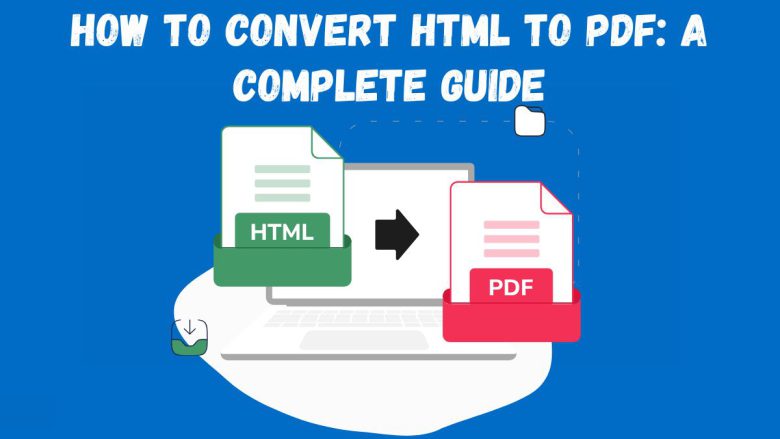
In today’s digital age, converting HTML files to PDF format has become a common need for both professionals and casual users. HTML is the standard markup language for web pages. But, PDFs are often preferred for sharing documents. They are reliable, have a uniform appearance, and work on all devices. This guide explains the benefits of converting HTML to PDF. It walks you through the process using FileProInfo’s free HTML to PDF converter. It also provides tips for a smooth experience.
Why Convert HTML to PDF?
Understanding the reasons for converting HTML files to PDF can help you determine if this format switch is right for your needs.
1. Universal Compatibility
HTML files are intended for web browsers, which means they can appear differently on various browsers and devices. PDF files are universally recognized. They keep the same formatting on all platforms. This is ideal for sharing documents.
2. Consistency in Formatting
One major advantage of PDFs is their consistency. Unlike HTML files, which can change based on CSS or device settings, PDFs keep their format on any platform. This keeps your document’s appearance intact. It’s suitable for reports, resumes, and presentations.
3. Enhanced Security Options
PDFs let you add password protection, encryption, and watermarks. They can safeguard sensitive information. HTML lacks built-in security features. So, PDF is a better option for confidential documents.
4. Professional Presentation
PDFs are generally seen as more professional than HTML files. They offer a clean, polished look that makes them ideal for official documents like reports, proposals, and portfolios. HTML files, on the other hand, are primarily built for web viewing and can sometimes lack the formal appeal that PDFs provide.
Advantages of Using FileProInfo for HTML to PDF Conversion
FileProInfo’s HTML to PDF converter is a convenient, user-friendly solution that comes with several benefits. Here’s why FileProInfo is an ideal choice:
1. Free Online Tool
FileProInfo offers a free online conversion tool that allows you to convert HTML files to PDF without any hidden fees. This is great for those who only need occasional file conversions and don’t want to invest in specialized software.
2. No Software Installation
Being an online tool, FileProInfo doesn’t require any software installation. You can access it from any device with internet connectivity, making it accessible for users on the go.
3. Easy-to-Use Interface
FileProInfo provides a straightforward, user-friendly interface. The simple layout makes it easy for both beginners and experienced users to convert files without any hassle.
4. Fast and Efficient Conversion
With FileProInfo, conversions are fast and reliable, allowing you to download your PDF file within seconds. This is especially useful for professionals who need quick, high-quality conversions.
5. Privacy and Security
FileProInfo protects your files. It deletes uploaded files after conversion. This guarantees that your information remains safe and secure throughout the process.
Step-by-Step Guide to Converting HTML to PDF Using FileProInfo
Let’s go through the conversion process in detail, showing how you can easily convert your HTML files to PDF with FileProInfo.
Step 1: Visit FileProInfo’s HTML to PDF Converter
Head to the FileProInfo HTML to PDF converter. You’ll find an interface designed for easy file uploading and conversion.
Step 2: Upload Your HTML File
Click on the “Choose File” button to upload your HTML file. Alternatively, you can drag and drop your file into the designated area. FileProInfo accepts various HTML file types, so whether it’s a basic text HTML or a complex web page, the tool can handle it.
Step 3: Start the Conversion Process
After uploading your HTML file, click on the “Convert” button. FileProInfo’s system will process the file and convert it into a PDF document. This typically takes only a few seconds, making it a convenient option even if you’re short on time.
Step 4: Download Your PDF File
Once the conversion is complete, a download link for the PDF file will appear. Click on it to download the PDF to your device. Your HTML file is now successfully converted to PDF, with all formatting and content intact.
Tips for a Smooth HTML to PDF Conversion
To make sure your PDF looks just like you want it to, consider these tips before you start the conversion.
1. Optimize Your HTML for Best Results
Ensure that your HTML code is clean and free from unnecessary elements. Well-organized HTML code is more likely to convert accurately and retain the original layout in the PDF.
2. Use Standard Fonts and Formatting
Stick to commonly supported fonts in your HTML document. Custom fonts may not work in PDFs. Use standard fonts like Arial, Helvetica, or Times New Roman for consistency.
3. Embed Images Correctly
Ensure that any images in your HTML are correctly linked or embedded to avoid issues during conversion. This will help maintain image quality and placement in the resulting PDF.
4. Review the PDF After Conversion
It’s always a good idea to open the converted PDF file and review it to ensure all elements appear as intended. If any formatting issues arise, you may need to adjust the HTML file and try the conversion again.
Troubleshooting Common Issues in HTML to PDF Conversion
While FileProInfo’s converter works well for most files, there are a few common issues users may encounter. Here are solutions for some of these problems:
1. Loss of Image Quality
If images appear pixelated, make sure your original HTML file has high-resolution images. Using high-quality images will help preserve clarity in the converted PDF.
2. Misaligned Text or Elements
If text or other elements are misaligned, check your HTML code. Simplify complex CSS and ensure that the HTML is structured logically. This will improve the chances of a clean conversion.
3. Hyperlinks Not Working
FileProInfo’s converter usually preserves hyperlinks. But, some may not work if your HTML is complex. After conversion, double-check your PDF to make sure links function correctly.
Best Practices for HTML to PDF Conversion
Here are a few best practices to keep in mind for smooth and accurate HTML to PDF conversion.
1. Keep HTML Code Simple
A simple HTML structure is easier to convert. So, avoid excessive CSS or JavaScript that might interfere with formatting.
2. Use Inline CSS for Small Files
For simple conversions, inline CSS in your HTML can improve PDF formatting.
3. Test Different Browsers Before Conversion
HTML files can display differently across browsers, so if possible, test your HTML on multiple browsers to ensure a uniform layout.
4. Check Page Breaks
If your HTML file contains multiple sections or pages, make sure to include logical page breaks. This will help create a well-organized PDF with easily navigable sections.
Conclusion
Converting HTML to PDF has many benefits. It ensures consistent formatting across devices and enhances document security. Use FileProInfo’s free HTML to PDF converter. It is fast, reliable, and easy to use. It preserves your original HTML file’s quality. FileProInfo simplifies the process. Use it for a quick personal conversion or to prepare a professional document for distribution.


